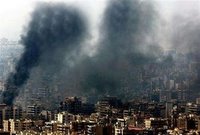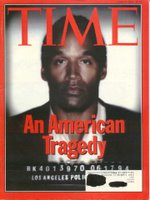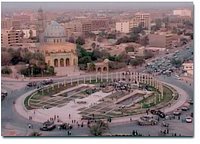
 Well, I'm a little nonplussed by the way blogger lets you add photos. It took me a few tries to get the photo on the left to be on the left.
Well, I'm a little nonplussed by the way blogger lets you add photos. It took me a few tries to get the photo on the left to be on the left.In any event, what you see us the before and after pictures from a photo retouching job I did. I wanted to post this because it's not something I do a lot of and I'm proud of this result. On the left is the original photo of a friend of mine. On the right, the adjusted product. The changes include changing the saturation and color balance to make the complexion a bit less ashen, thinning the face, moving the right jowl inward and eliminating the bulge a the neck, lowering the forehead, evening out the hairline, making the stubble less obvious and less grey, eliminating the veins on the forehead, darkening the eyebrows, and, of course, covering my tracks so the retouching job isn't totally obvious. I left plenty of clues for FBI laboratory staff if they ever wanted to test the authenticity of this photo, but with limited time for the project, I think I made it look pretty convincing to the naked eye.
So, beyond that bragging, I did have a retouching thread that I've been wanting to post for a while. Remember that Reuters photographer who retouched some of his photos of Israeli strikes in Iraq, Adnan Hajj? He basically added some dark smoke to a photo depicting an Israeli airstrike.
 He also did a crappy job. You can see that he basically copied a billow of smoke on photoshop and repasted it at intervals to add additional volume.
He also did a crappy job. You can see that he basically copied a billow of smoke on photoshop and repasted it at intervals to add additional volume.But of course the issue is not that he's an unskilled manipulator. Nor is it that there was any material misrepresentation involved. While supporters of the Israeli attacks screamed bloody murder and got Hajj suspended, let's be clear. The attack was real. It did make smoke. The photo was not fabricated out of whole cloth. Nor was the amount of smoke an important issue for which the photo provided evidence. Opponents of the attacks objected on the grounds that they killed, injured, or displaced a million people, mostly innocent people, violated international law, inflicted huge damage on the economy of Lebanon, and were counterproductive to their own stated goals. I don't recall a lot of people saying, Israel should stop its war because it makes too much smoke and that's really affecting air quality in the region.
No, the issue was, or supposedly would be, that any manipulation threatens the credibility of the publisher, so there is a need to be circumspect with respect to the integrity of photos regardless of whether they are used as evidence of a material point, or merely seek to entertain the eye and illustrate an event. But if that is true, what about all the other manipulation that takes place?

 Take for example, the famous occasion of Time magazine darkening the mug shot of O.J. Simpson, making him look more African and at the same time, more sinsiter and obscure. This was done reportedly for asthetic reasons rather than editorial ones. The cover was conceived as an illustration rather than a photo attesting to reality, and it was assembled with a symbolic black-and-white theme. You can see that an iris effect was added to the background, the color
Take for example, the famous occasion of Time magazine darkening the mug shot of O.J. Simpson, making him look more African and at the same time, more sinsiter and obscure. This was done reportedly for asthetic reasons rather than editorial ones. The cover was conceived as an illustration rather than a photo attesting to reality, and it was assembled with a symbolic black-and-white theme. You can see that an iris effect was added to the background, the colorsaturation was reduced, and even the color balance changed to be more reddish. The slate reading "BK4013970 061794 Los Angeles Police Jail Div" was also shrunk, and everything unrelated to the article is kept off the cover. So I get that the idea was conceived as being artistic rather than racist, but I think the manipulation was consequential and rightly criticized.
Other examples are, contempraneous to the Lebanon manipulation story, slimming down Katie Couric as she was slated to become CBS' new anchor, in CBS magazine, which was arguably an effort to sell the CBS Nightly News based on her looks. In this case, it's a matter of both false advertising, and debasing both the news and Couric by treating her as eye candy and the evening newscast as a form of entertainment whose essential quality is represented by the looks of its anchor.
More serious, though it involves a pretty standard photo trick requiring less sophisticated manipulation.
 This was the April 9, 2003 toppling of the statute of Saddam Hussein in Firdos Square. Although the initially released photos appeared to show a substantial crowd of cheering Iraqis spontaneously pulling down the statue and celebrating, photos available at the time and later released showed that the crowd was insubstantial, concentrated entirely within the visual field of the cropped photo that appeared in countless papers.
This was the April 9, 2003 toppling of the statute of Saddam Hussein in Firdos Square. Although the initially released photos appeared to show a substantial crowd of cheering Iraqis spontaneously pulling down the statue and celebrating, photos available at the time and later released showed that the crowd was insubstantial, concentrated entirely within the visual field of the cropped photo that appeared in countless papers.Outside of that field, cropped off the bottom and sides of the picture, were two things:

1) the emptiness of a mostly deserted square, and
2) a U.S. military presence, which included the tank which actually pulled down the statue.
(Observers also noted that some of the members of the crowd were apparently plants, since the same individuals appeared in other crowd photos around the country and at least one was photographed as part of Ahmed Chalabi's entourage as they arrived in the country.)
Here the manipulation was not any sophisticated retouching, but merely cropping. Another common device is foreshortening. When a long lens is used, the viewer seems to be close to the action, because the image is large, but the sense of perspective is diminished, as when a scene is viewed from far away. The effect is that objects in the foreground and background appear to be separated by little distance along the axis of viewing, though they may in fact be a considerable distance apart.
Of course the point with Couric and OJ and Firdos Square is that, to my knowledge, none of these tricks prompted anyone to be suspended, or have their entire portfolio scanned for deceptions. A story on the Couric affair had a CBS exec laughing the whole thing off and treating it as trivial. It may be, simply given how common manipulation is in one form or another.
One could itemize other forms of manipulation, such as the mere decision to cover staged pseudo-events, which comprise perhaps a majority of all news, or helping to stage photos, or selecting subjects or angles or filters that make photographs dramatic and asthetic and thus fail to capure the boring reality that is their real subject.
Anyhow, the big deal over Hajj is overblown in relative terms, or perhaps all the other cases are simply underblown.

No comments:
Post a Comment